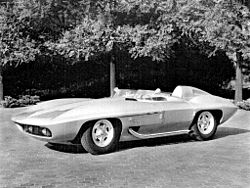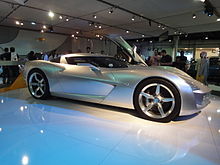- Corvette Stingray (concept car)
-
Corvette Stingray
(concept car) Corvette Sting Ray racer-concept
Corvette Sting Ray racer-conceptManufacturer Chevrolet Division
of General MotorsClass Sports car Body style 2-door convertible Designer Pete Brock
Bill Mitchell
Larry ShinodaThe Corvette Stingray was a privately funded concept car that formed a basis for the second (C2) generation Corvette Sting Ray. The Stingray racer-concept car was designed by Pete Brock the youngest designer to work at GM at that time, Bill Mitchell, GM Vice President of styling, and Larry Shinoda in 1957. The basis of the Stingray was the 1957 Corvette SS, an engineering test mule chassis for the creation of an official Chevrolet race effort culminating with the 24 Hours of LeMans. Soon after its race debut, the Automobile Manufacturers Association (AMA) banned manufacturer-sponsored racing, and the SS had been relegated to test track duty. The Stingray exists today with a 327-cubic-inch (5.4 L), fuel-injected V-8 of 375 hp (280 kW).
Contents
History
Design and development
The Stingray used elements of the still-born Q-Corvette design study as well as the SS underpinnings, featuring a 92-inch (2,337 mm) wheelbase. The new car was exceptionally light, with a dry weight of 2,200 pounds, nearly 1,000 lb (450 kg) lighter than a 1960 production car. Its fuel-injected small-block 283-cubic-inch (4.6 L) V-8 engine produced 315 horsepower (235 kW) at 6,200 rpm. The Stingray body design strongly influenced the styling of the next generation Corvette, which saw production as a 1963 model. It also was a test bed for many technical developments, including the four-speed manual transmission, extensive use of aluminum and a de Dion rear suspension.
Operational history
Billed as a car "built to test handling ease and performance," Bill Mitchell arranged to race the car quite extensively. In the hands of Dr. Dick Thompson, it made its debut at Maryland's Marlboro Raceway on 18 April 1959, finishing in fourth place. It went on to win an SCCA National Championship in 1960.
The Stingray was then retired from racing and modified by Mitchell with, among other things, a passenger seat added. The modified vehicle was exhibited as an experimental show car even while Mitchell regularly drove it personally on weekends. After its career as a concept car was finished, it was retained by the GM Design Studio as a historically significant vehicle.
Specifications
1957 Stingray Racer
- Frame:Space frame
- Body: Fiberglass
- Engine location: Front
- Drive type: Rear wheel
- Weight: 2,200 lb (1,000 kg)
- Engine
- Engine configuration: V
- Cylinders: 8
- Aspiration/Induction: Normal
- Displacement: 283.00 in³ | 4638 cc
- Valvetrain: OHV
- Power: 315 hp (235 kW) @ 6200 rpm
- Torque: 295.00 ft·lbf (400 N·m) @ 4700 rpm
- Power-to-weight ratio: 7.0 lb/hp
- Power-to-volume ratio: 68.5 bhp/L
- Bore: 3.87 in | 98.3 mm
- Stroke: 3.00 in | 76.2 mm
- Compression Ratio: 11.0:1
2009 Stingray Concept
Also referred to as the Corvette Centennial, the 50th Anniversary Stingray show car debuted at the Chicago Auto Show February 2009. Design and technology came together to celebrate Corvette's past, present and future.
DETROIT – Chevrolet delivers a futuristic vision of technology and design with the 50th Anniversary Corvette Stingray Concept. A version of the model was first shown at the 2009 Chicago Auto Show and stars as "Sideswipe" in Transformers: Revenge of the Fallen. The Corvette Stingray Concept represents both the iconic legacy and an exciting future for Corvette.
The Corvette Stingray Concept was developed as an internal design challenge to combine classic Corvette cues with surprisingly high-tech features, modern materials, and a striking new appearance. The car is well-appointed with a clamshell hood, scissor-style doors, ergonomic seats, rear-view camera with night vision enhancement, and a high performance hybrid drive. Interactive touch controls allow the driver to customize the power and efficiency of his or her ride and share it with friends via the in-car camera system and advanced telemetrics.[1]It has been rumored to be the basis of the C7 corvette.
See also
References
- Friedman, Dave and Paddock, Lowell C. Corvette Grand Sport: Photographic Race Log of the Magnificent Chevrolet Corvette Factory Specials 1987-1998. St. Paul, Minnesota: MBI Publishing Co., 1989. ISBN 0-87938-382-8.
- Mueller, Mike. Corvette Milestones. St. Paul, Minnesota: MBI Publishing Co., 1996. ISBN 0-7603-0095-X.
- Nichols, Richard. Corvette: 1953 to the Present. London: Bison Books, 1985. ISBN 0-86124-218-1.
- ^ Chevrolet press release
External links
Type 1950s 1960s 1970s 1980s 1990s 2000s 2010s 3 4 5 6 7 8 9 0 1 2 3 4 5 6 7 8 9 0 1 2 3 4 5 6 7 8 9 0 1 2 3 4 5 6 7 8 9 0 1 2 3 4 5 6 7 8 9 0 1 2 3 4 5 6 7 8 9 0 1 3-box coupe C2 C3 C5 Fastback coupe Col. Ed. C4 C5 C6 Convertible C1 C2 C3 C4 C5 C6 Performance Fuel Injection Big Block ZR-1 LT4 Z06 Z06 L84 Big Block LT1 ZR1 Motorsports: Grand Sport • GTP • C5-R • C6.R « previous – Chevrolet, a division of General Motors, road car timeline, United States market, 1980s–present Type 1980s 1990s 2000s 2010s 0 1 2 3 4 5 6 7 8 9 0 1 2 3 4 5 6 7 8 9 0 1 2 3 4 5 6 7 8 9 0 1 2 Subcompact Sprint Geo Metro Chevette Aveo Sonic Spectrum Monza Nova Compact Prizm Volt Cavalier Cavalier Cavalier HHR Citation Cobalt Cruze Mid-size Malibu Corsica / Beretta Malibu Malibu Malibu Celebrity Lumina Lumina Full-size Impala Impala SS Impala Impala Caprice Caprice Caprice Personal Monte Carlo Monte Carlo Monte Carlo Monte Carlo Sports Camaro Camaro Camaro Camaro Corvette Corvette Corvette Corvette Categories:- Chevrolet concept vehicles
- Chevrolet Corvette
- Rear wheel drive vehicles
- Sports cars
- Roadsters
- 1950s automobiles
Wikimedia Foundation. 2010.

